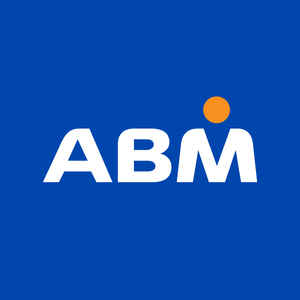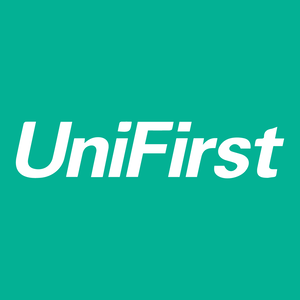
UniFirst (UNF)
UniFirst doesn’t excite us. Its weak sales growth and low returns on capital show it struggled to generate demand and profits.― StockStory Analyst Team
1. News
2. Summary
Why We Think UniFirst Will Underperform
With a fleet of trucks making weekly deliveries to over 300,000 customer locations, UniFirst (NYSE:UNF) provides, rents, cleans, and maintains workplace uniforms and protective clothing for businesses across various industries.
- Earnings growth underperformed the sector average over the last five years as its EPS grew by just 2.3% annually
- Estimated sales growth of 2.2% for the next 12 months implies demand will slow from its two-year trend
- On the bright side, its decent 6.2% annual revenue growth over the last five years beat most of its peers, showing customers find value in its products and services


UniFirst falls below our quality standards. There are superior stocks for sale in the market.
Why There Are Better Opportunities Than UniFirst
High Quality
Investable
Underperform
Why There Are Better Opportunities Than UniFirst
UniFirst’s stock price of $199.08 implies a valuation ratio of 28.4x forward P/E. This multiple is higher than most business services companies, and we think it’s quite expensive for the quality you get.
There are stocks out there similarly priced with better business quality. We prefer owning these.
3. UniFirst (UNF) Research Report: Q3 CY2025 Update
Workplace uniform provider UniFirst (NYSE:UNF) announced better-than-expected revenue in Q3 CY2025, but sales fell by 4% year on year to $614.4 million. On the other hand, the company’s full-year revenue guidance of $2.49 billion at the midpoint came in 0.8% below analysts’ estimates. Its GAAP profit of $2.23 per share was 7.5% above analysts’ consensus estimates.
UniFirst (UNF) Q3 CY2025 Highlights:
- Revenue: $614.4 million vs analyst estimates of $607.9 million (4% year-on-year decline, 1.1% beat)
- EPS (GAAP): $2.23 vs analyst estimates of $2.07 (7.5% beat)
- Adjusted EBITDA: $88.07 million vs analyst estimates of $88.18 million (14.3% margin, in line)
- EPS (GAAP) guidance for the upcoming financial year 2026 is $6.78 at the midpoint, missing analyst estimates by 20.9%
- Operating Margin: 8.1%, in line with the same quarter last year
- Free Cash Flow Margin: 9.1%, similar to the same quarter last year
- Market Capitalization: $3.21 billion
Company Overview
With a fleet of trucks making weekly deliveries to over 300,000 customer locations, UniFirst (NYSE:UNF) provides, rents, cleans, and maintains workplace uniforms and protective clothing for businesses across various industries.
UniFirst operates on a service model where it not only supplies uniforms but also handles the entire lifecycle of workplace apparel. The company picks up soiled garments from customers on a regular schedule (typically weekly), cleans and processes them at their facilities, and delivers fresh replacements—all managed through service contracts that generally run three to five years.
The company manufactures approximately 60% of the garments it places into service, with production facilities in Mexico and Nicaragua. This vertical integration allows UniFirst to offer customized uniform programs for larger clients and maintain quality control over its products.
Beyond standard uniforms like shirts, pants, and jackets, UniFirst provides specialized protective wear including flame-resistant and high-visibility garments. For certain industries, the company offers decontamination services for clothes exposed to radioactive materials and cleanroom garment processing.
UniFirst's customer base spans businesses of all sizes across most industry sectors. Auto service centers, food retailers, healthcare providers, manufacturers, restaurants, and transportation companies all rely on UniFirst to outfit their employees with appropriate workplace attire that serves functional needs while maintaining consistent branding.
The company has expanded beyond just garments to offer complementary workplace products including industrial wiping materials, floor mats, mops, restroom supplies, and safety equipment. This diversification allows UniFirst to be a more comprehensive workplace solutions provider for its customers.
UniFirst generates revenue through several service models: full-service rental programs where the company handles all cleaning and maintenance, lease programs where employees maintain the garments themselves, and direct purchase programs for customers who prefer to buy rather than rent.
4. Industrial & Environmental Services
Growing regulatory pressure on environmental compliance and increasing corporate ESG commitments should buoy the sector for years to come. On the other hand, environmental regulations continue to evolve, and this may require costly upgrades, volatility in commodity waste and recycling markets, and labor shortages in industrial services. As for digitization, a theme that is impacting nearly every industry, the increasing use of data, analytics, and automation will give rise to improved efficiency of operations. Conversely, though, the benefits of digitization also come with challenges of integrating new technologies into legacy systems.
UniFirst's main competitors in the uniform rental and workplace solutions industry include Cintas Corporation (NASDAQ:CTAS), Alsco (privately held), and Vestis Corporation (NYSE:VSTS), all of which offer similar uniform rental and facility services programs.
5. Revenue Growth
A company’s long-term performance is an indicator of its overall quality. Any business can put up a good quarter or two, but the best consistently grow over the long haul.
With $2.43 billion in revenue over the past 12 months, UniFirst is a mid-sized business services company, which sometimes brings disadvantages compared to larger competitors benefiting from better economies of scale. On the bright side, it can still flex high growth rates because it’s working from a smaller revenue base.
As you can see below, UniFirst’s 6.2% annualized revenue growth over the last five years was decent. This shows its offerings generated slightly more demand than the average business services company, a useful starting point for our analysis.
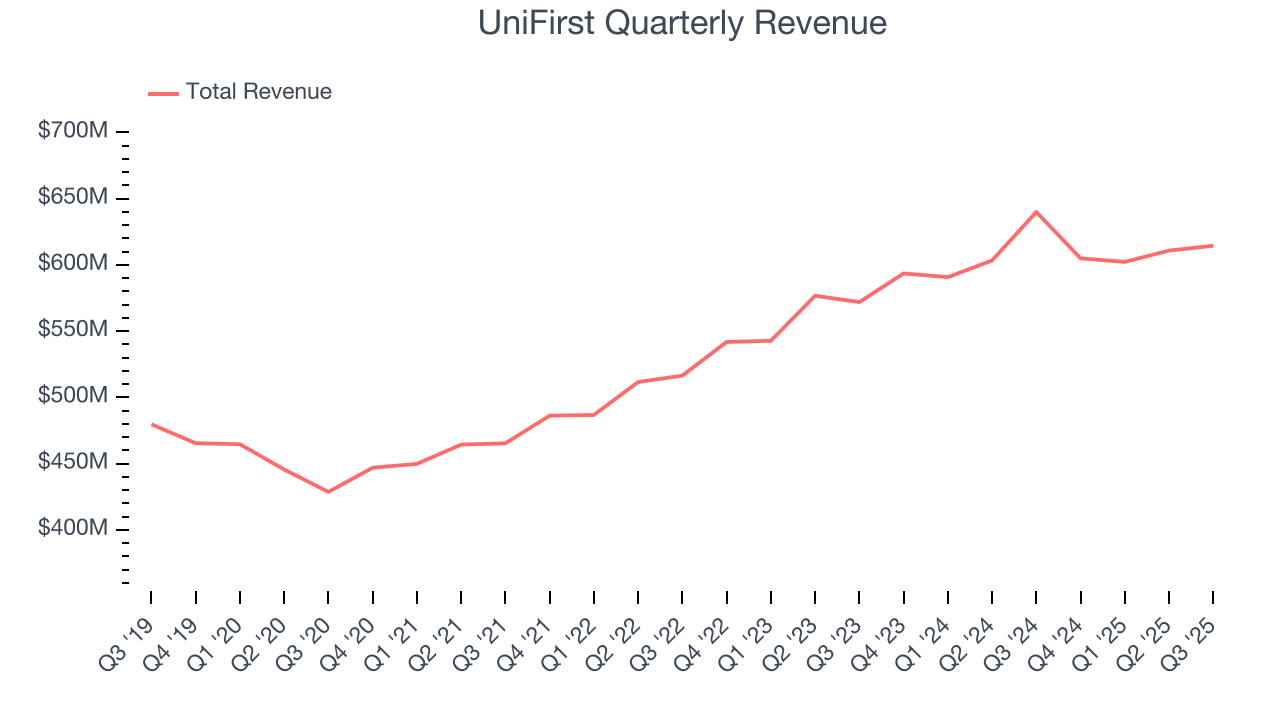
We at StockStory place the most emphasis on long-term growth, but within business services, a half-decade historical view may miss recent innovations or disruptive industry trends. UniFirst’s recent performance shows its demand has slowed as its annualized revenue growth of 4.4% over the last two years was below its five-year trend. 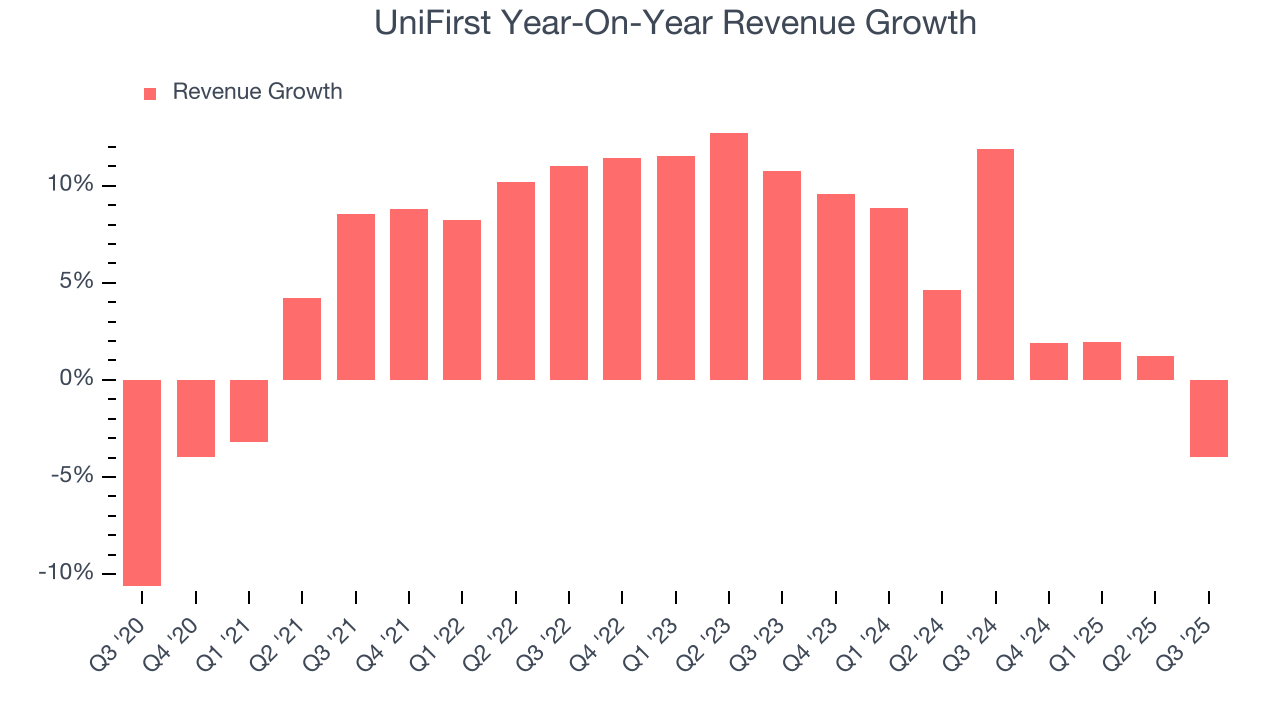
This quarter, UniFirst’s revenue fell by 4% year on year to $614.4 million but beat Wall Street’s estimates by 1.1%.
Looking ahead, sell-side analysts expect revenue to grow 3% over the next 12 months, similar to its two-year rate. This projection is underwhelming and suggests its products and services will see some demand headwinds.
6. Operating Margin
UniFirst was profitable over the last five years but held back by its large cost base. Its average operating margin of 7.5% was weak for a business services business.
Analyzing the trend in its profitability, UniFirst’s operating margin decreased by 2.5 percentage points over the last five years. This raises questions about the company’s expense base because its revenue growth should have given it leverage on its fixed costs, resulting in better economies of scale and profitability. UniFirst’s performance was poor no matter how you look at it - it shows that costs were rising and it couldn’t pass them onto its customers.

This quarter, UniFirst generated an operating margin profit margin of 8.1%, in line with the same quarter last year. This indicates the company’s overall cost structure has been relatively stable.
7. Earnings Per Share
We track the long-term change in earnings per share (EPS) for the same reason as long-term revenue growth. Compared to revenue, however, EPS highlights whether a company’s growth is profitable.
UniFirst’s EPS grew at a weak 2.3% compounded annual growth rate over the last five years, lower than its 6.2% annualized revenue growth. This tells us the company became less profitable on a per-share basis as it expanded due to non-fundamental factors such as interest expenses and taxes.
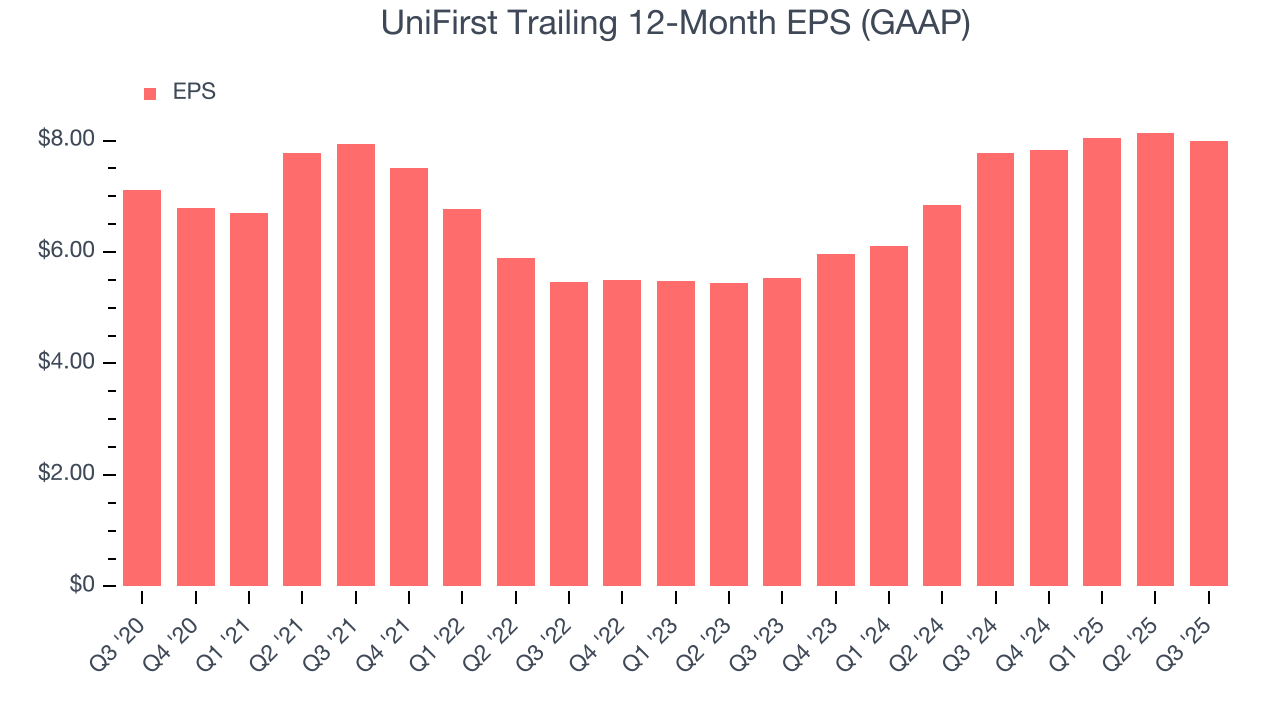
We can take a deeper look into UniFirst’s earnings to better understand the drivers of its performance. As we mentioned earlier, UniFirst’s operating margin was flat this quarter but declined by 2.5 percentage points over the last five years. This was the most relevant factor (aside from the revenue impact) behind its lower earnings; interest expenses and taxes can also affect EPS but don’t tell us as much about a company’s fundamentals.
Like with revenue, we analyze EPS over a shorter period to see if we are missing a change in the business.
For UniFirst, its two-year annual EPS growth of 20.2% was higher than its five-year trend. This acceleration made it one of the faster-growing business services companies in recent history.
In Q3, UniFirst reported EPS of $2.23, down from $2.39 in the same quarter last year. Despite falling year on year, this print beat analysts’ estimates by 7.5%. Over the next 12 months, Wall Street expects UniFirst’s full-year EPS of $7.98 to grow 6.5%.
8. Cash Is King
Free cash flow isn't a prominently featured metric in company financials and earnings releases, but we think it's telling because it accounts for all operating and capital expenses, making it tough to manipulate. Cash is king.
UniFirst has shown weak cash profitability over the last five years, giving the company limited opportunities to return capital to shareholders. Its free cash flow margin averaged 3.5%, subpar for a business services business.
Taking a step back, an encouraging sign is that UniFirst’s margin expanded by 1.6 percentage points during that time. The company’s improvement shows it’s heading in the right direction, and we can see it became a less capital-intensive business because its free cash flow profitability rose while its operating profitability fell.
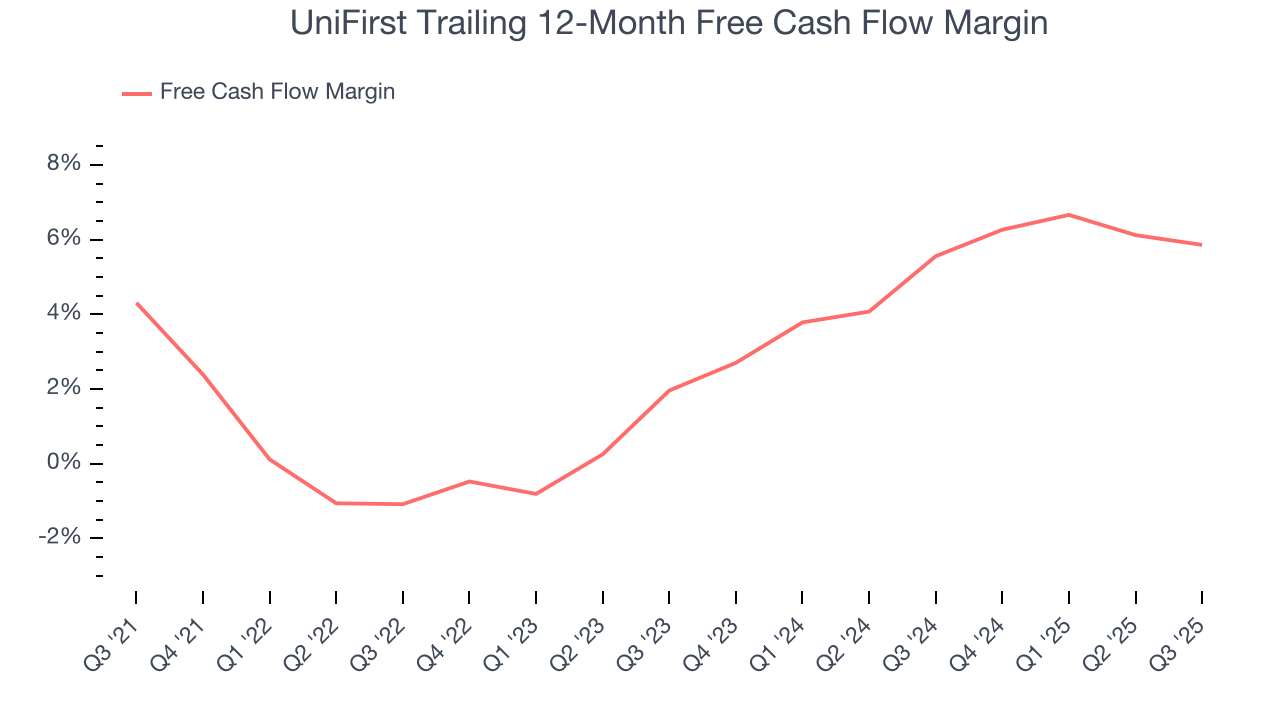
UniFirst’s free cash flow clocked in at $55.87 million in Q3, equivalent to a 9.1% margin. This cash profitability was in line with the comparable period last year and above its five-year average.
9. Return on Invested Capital (ROIC)
EPS and free cash flow tell us whether a company was profitable while growing its revenue. But was it capital-efficient? Enter ROIC, a metric showing how much operating profit a company generates relative to the money it has raised (debt and equity).
UniFirst historically did a mediocre job investing in profitable growth initiatives. Its five-year average ROIC was 7.3%, somewhat low compared to the best business services companies that consistently pump out 25%+.
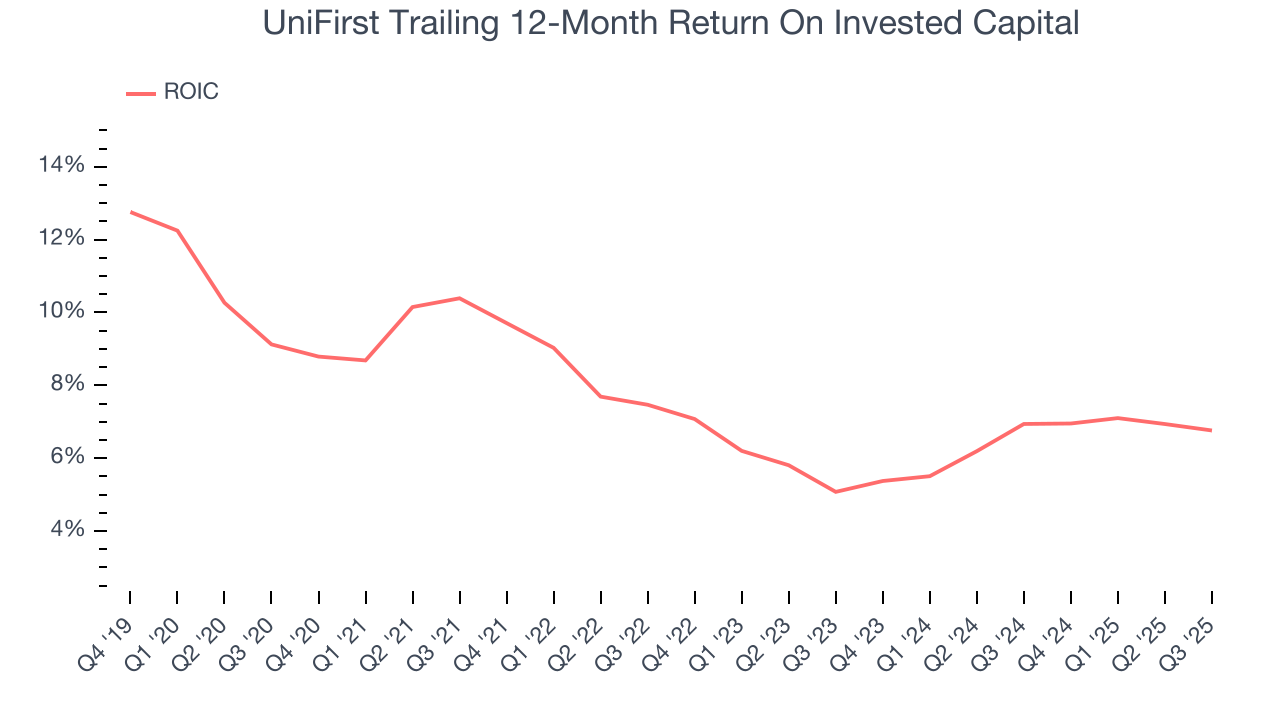
We like to invest in businesses with high returns, but the trend in a company’s ROIC is what often surprises the market and moves the stock price. Unfortunately, UniFirst’s ROIC averaged 2.1 percentage point decreases over the last few years. Paired with its already low returns, these declines suggest its profitable growth opportunities are few and far between.
10. Balance Sheet Assessment
One of the best ways to mitigate bankruptcy risk is to hold more cash than debt.
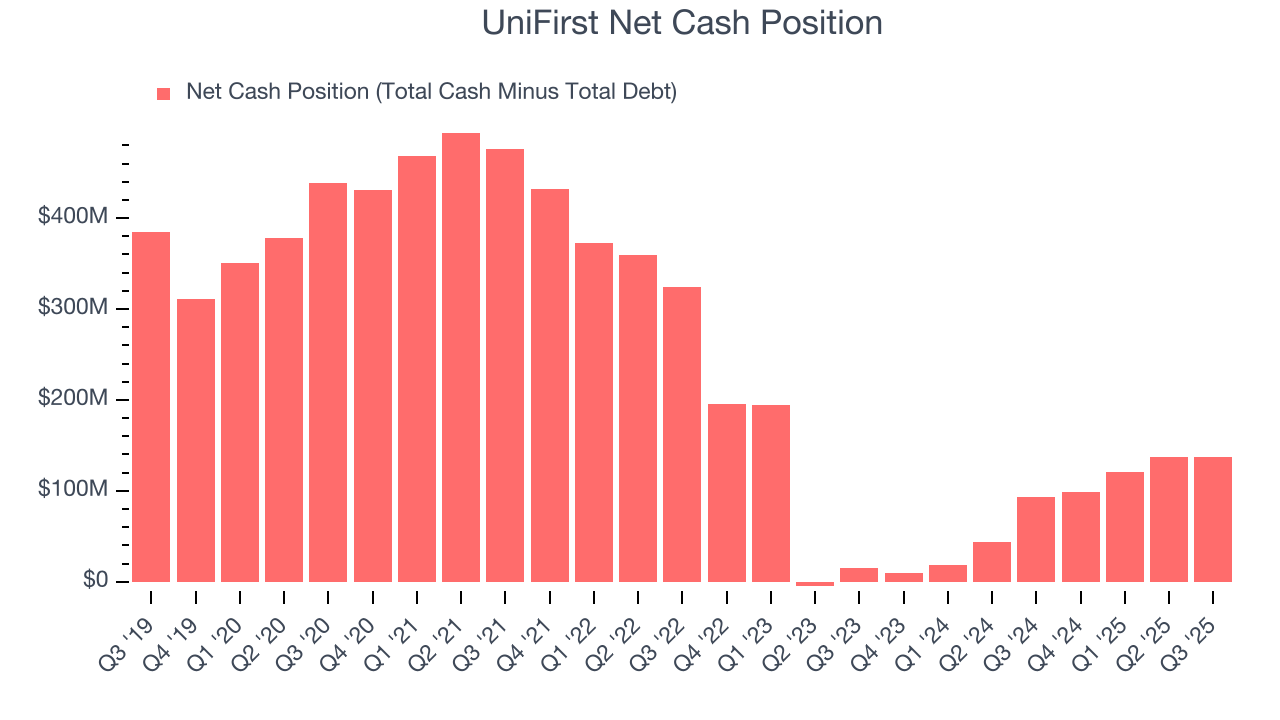
UniFirst is a profitable, well-capitalized company with $209.2 million of cash and $72.44 million of debt on its balance sheet. This $136.7 million net cash position is 4.3% of its market cap and gives it the freedom to borrow money, return capital to shareholders, or invest in growth initiatives. Leverage is not an issue here.
11. Key Takeaways from UniFirst’s Q3 Results
It was good to see UniFirst beat analysts’ EPS expectations this quarter. We were also happy its revenue narrowly outperformed Wall Street’s estimates. On the other hand, its full-year EPS guidance missed and its full-year revenue guidance fell slightly short of Wall Street’s estimates. Overall, this quarter could have been better. The stock traded down 5.1% to $164.58 immediately following the results.
12. Is Now The Time To Buy UniFirst?
Updated: December 24, 2025 at 10:10 PM EST
Before deciding whether to buy UniFirst or pass, we urge investors to consider business quality, valuation, and the latest quarterly results.
UniFirst’s business quality ultimately falls short of our standards. Although its revenue growth was good over the last five years, it’s expected to deteriorate over the next 12 months and its projected EPS for the next year is lacking. And while the company’s rising cash profitability gives it more optionality, the downside is its weak EPS growth over the last five years shows it’s failed to produce meaningful profits for shareholders.
UniFirst’s P/E ratio based on the next 12 months is 28.4x. This valuation tells us a lot of optimism is priced in - you can find more timely opportunities elsewhere.
Wall Street analysts have a consensus one-year price target of $167.33 on the company (compared to the current share price of $199.08), implying they don’t see much short-term potential in UniFirst.









